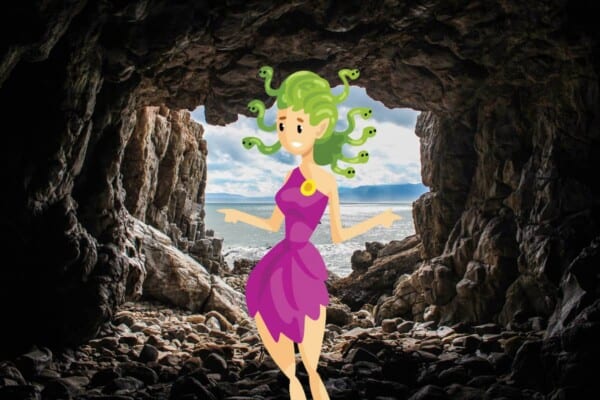Medusa is certainly the most famous of the three Gorgons, cursed by Athena to have snakes for hair and a look that could turned men to stone, but why did Athena curse her?
There are a few versions of the story of Medusa. Depending on the myth, Poseidon either raped her or had consensual sex with her in one of Athena’s temples. Athena cursed her as punishment for defiling a sacred place, despite Poseidon being the one with power and Medusa likely being unwilling.
Was Athena Jealous of Medusa?
Jealousy is a driving force in Greek myth, as is pride, and none are more jealous and prideful than the Olympians. Athena’s actions are often considered based on jealousy of Medusa’s beauty.
Indeed, this interpretation has some roots in other stories; the entire Trojan War began when Athena, Aphrodite, and Hera competed over the apple of Eris (Discord) to see who was most beautiful. The human Paris chose Aphrodite, and the angry runners up retaliated.
Some modern readings like to reinterpret Athena’s transformation of Medusa as not a curse but protection and strength. After being raped by Poseidon, Athena, the protectress, made it so that no man could hurt Medusa again. While this is an inspiring story and speaks wonders for the feminist idol that Medusa has become, it is somewhat flawed when examining the other aspects of the tale!
Athena did not only curse Medusa but also her sisters. She also aided Perseus in later killing Medusa once and for all. After Perseus removed Medusa’s head, some stories claim that he gifted it to Athena. The goddess’s shield has a gorgon head in the center. According to some myths, this was the real head of Medusa.
Some Classicists note how the usually competitive and wise Athena blamed Medusa for an act which, whether rape or consensual, was clearly an insult to her by Poseidon. This is often analyzed as another form of jealousy. Some read it as a reflection of the complex relationship between Athena and the other Olympians, especially her father, Zeus.
Athena herself was a virgin goddess who never had a childhood. She was born fully grown from her father’s forehead because Zeus swallowed her mother. In this way, she is bound to Zeus more fully than the other Olympians, even his other children, and she has the least sense of her own freedom.
What Were the Consequences of the Curse on Medusa?
As the stories go, the three Gorgons were the children of the primordial god and goddess of the sea, Phorcys, and Ceto. Although the older sisters – Stheno (“forceful”) and Euryale (“far-roaming”) were immortal, the youngest, Medusa (“female guardian”), was not.
All three were lovely and humanoid before the curse of Athena, which turned them into hideous monsters. Stheno and Euryale were cursed simply for standing with their sister. Poseidon was not punished for the act.
Though all three were beautiful before, Athena’s curse made the Gorgons into hideous monsters.
Medusa – Her lovely long hair turned to green snakes, and her gaze could turn someone to stone. Though she was often still portrayed as beautiful except for these traits, many other sources portray her as becoming hideous and monstrous, with scales, red eyes, sharp bronze claws, and metallic wings.
Stheno – After objecting to her sister’s curse, Stheno was also transformed by Athena. She became the deadliest Gorgon of them all, killing more men than her sisters combined. Some sources have her as a hideous tusked monster, while most have her as a monstrous woman with red snakes for hair.
Euryale – Also cursed for objecting to Medusa’s punishment, Euryale was also snake-haired. Her gaze could sometimes cause people to turn to stone, but her power was in the loud cries and wails she could release from her mouth. These wails often had destructive power.
Medusa eventually became such a dangerous monster that Perseus was aided by the gods – especially Athena and Hermes – in slaying her by removing her head. One of the most famous Greek myth iconographies is Perseus wielding the still-dangerous severed head of Medusa against his enemies to turn them to stone.
How is Medusa Used as a Modern Symbol?
In more modern times, Medusa has become somewhat of a feminist icon! As well as this, her story has been reinterpreted by several companies and movements in several different ways. Her design has been used in branding, logos, protests, and more.
Symbol Reason
Versace (fashion brand) Medusa’s enigmatic smile makes up their logo Gianni Versace claimed that her “fatal passion” made her the ideal face of his company.
Feminist Writers and Critics (see: Women: A Journal of Liberation (Lupton, 1978); Gorgons: A Face for Contemporary Women’s Rage (Culpepper, 1986); ‘Nasty Women’ (Johnston, 2016)) She is often written as a symbol of female rage against society’s injustice, sexual assault, and hypermasculinity. Medusa’s story as a victim-blamed for her own rape still echoes with much feminist thought today.
As well, her death at Perseus’s hand is often shown as monstrously unfair, as the man is centered and supposedly blameless.
The MeToo Movement Luciano Garbani’s statue ‘Medusa with the Head of Perseus’ The statue flipped the role of victor and conquered.
Nihilism (see: The Mutiny of the Elsinore (London, 1914) She is used as a symbol of the meaninglessness of the universe. Rather than literally turning men to stone, Medusa avoids meeting people’s eyes as they show the truth about the bleakness of the world
That’s not to say that Medusa is never used as a good old monstrous villain, though. She appears, for good and for evil, in plenty of books, movies, and shows. Some examples include:
The Percy Jackson books. Just like the original Perseus, Medusa is an antagonist against Percy and his friends.
The Castlevania games have Medusa as a recurring enemy.
Assassin’s Creed: Odyssey, set in Ancient Greece, features a Medusa who was not transformed by Athena but instead transformed by experimentation gone wrong.
The character Dusa in Hades is a floating head who serves as a maid in the House of Hades. It is strongly implied that she was a monstrous Gorgon whose decapitated head took on a new life, especially as she claims that she is very different from other Gorgons.
Medusa also appeared as a character in the 1981 Clash of the Titans and its 2010 remake. These movies perhaps were the freest when interpreting the biology and powers of Medusa. Her face is human and beautiful in the more recent version – until she turns dangerously monstrous.
Final Thoughts
Perhaps more than any other, Athena and Medusa’s story is greatly open to analysis and controversy both by classicists and those with an amateur interest in mythology. By her very existence, Medusa throws into question the morality of one of the most favored Olympians in Athena.
The many interpretations and reinterpretations of Medusa’s story are particularly interesting because they truly exemplify how myths change and grow as societies do. Originally read as an immoral seductress, the shifting perspective to unjustly blamed victims shows changes in how we view women, society, and power.
The Greek gods were a jealous lot, and even the great Athena was no exception. Perhaps the most fascinating thing about Greek myth, though, is precisely this. No god was free of flaws, from Athena to Zeus and anywhere in between. They were not worshipped for their perfection – rather, for their virtues. At the same time, their flaws reminded people of their irrevocable connection to humanity.













